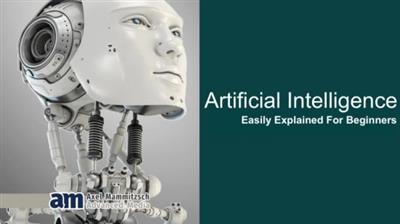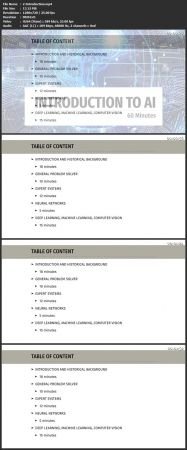Artificial Intelligence (AI) - Simply Explained for Beginners
- 25.07.2021
- 123

Duration: 57m | Video: .MP4 1280x720, 30 fps(r) | Audio: AAC, 44100 Hz, 2ch | Size: 314 MB
Genre: eLearning | Language: English
Genre: eLearning | Language: English
This video course on artificial intelligence is aimed at beginners and is designed to teach you the basics within the historical development of AI. For this reason, our journey begins with the section "Introduction and historical background of AI".
Topics and contents of the lessons:
I. Introduction and historical background
What is AI - a philosophical consideration
Strong and Weak AI
The Turing Test
The birth of the AI
The era of great expectations
Catching up with reality
How to teach a machine to learn
Distributed systems in the AI
Deep Learning, Machine Learning, Natural Language Processing
II. The general problem solver
Proof Program - Logical Theorist
Example from "Human Problem Solving" (Simon)
The structure of a problem
In this section, we first take up the initial techniques of AI. You will learn about the concepts and famous example systems that triggered this early phase of euphoria.
III. Expert Systems
Factual knowledge and heuristic knowledge
Frames, Slots and Filler
Forward and backward chaining
The MYCIN Programme
Probabilities in expert systems
Example - Probability of hairline cracks
In this section, we discuss expert systems that, similar to the general problem solvers, only deal with specific problems. But instead, they use excessive rules and facts in the form of a knowledge base.
IV. Neuronal Networks
The human neuron
Signal processing of a neuron
The Perceptron
This section heralds a return to the idea of being able to reproduce the human brain and thus make it accessible to digital information processing in the form of neural networks. We look at the early approaches and highlight the ideas that were still missing to help neural networks achieve a breakthrough.
V. Machine Learning (Deep Learning & Computer Vision)
Example - potato harvest
The birth year of Deep Learning
Layers of deep learning networks
Machine Vision / Computer Vision
Convolutional Neural Network.
The idea of an agent and its interaction in a multi-agent system is described in the fifth section. The main purpose of such a system is to distribute complexity over several instances.
The sixth section deals with the breakthrough of multi-layer neural networks, machine learning, machine vision, speech recognition and some other applications of today's AI.
Homepage
Screenshots

Download link:
rapidgator_net:
https://rapidgator.net/file/0970827f89efefcb37ed90cca91acc02/ve5qy.Artificial.Intelligence.AI..Simply.Explained.for.Beginners.rar.html
uploadgig_com:
https://uploadgig.com/file/download/e4dEbBeb1e88c4a2/ve5qy.Artificial.Intelligence.AI..Simply.Explained.for.Beginners.rar
nitroflare_com:
https://nitro.download/view/37605FC2904A2F9/ve5qy.Artificial.Intelligence.AI..Simply.Explained.for.Beginners.rar
https://rapidgator.net/file/0970827f89efefcb37ed90cca91acc02/ve5qy.Artificial.Intelligence.AI..Simply.Explained.for.Beginners.rar.html
uploadgig_com:
https://uploadgig.com/file/download/e4dEbBeb1e88c4a2/ve5qy.Artificial.Intelligence.AI..Simply.Explained.for.Beginners.rar
nitroflare_com:
https://nitro.download/view/37605FC2904A2F9/ve5qy.Artificial.Intelligence.AI..Simply.Explained.for.Beginners.rar
Links are Interchangeable - No Password - Single Extraction